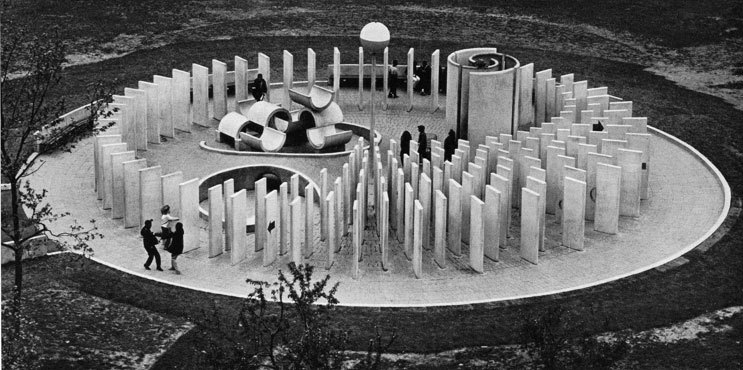
The very last playspace I talked about at Sheffield was the Cypress Hills Playground, by architect Charles Forberg. It’s notable for being one of the playgrounds driven by the Museum of Modern Art’s ongoing advocacy for better design in play, which continued well beyond its famous 1954 competition and remains the best example of how the overlap between art and play can help drive innovation. All those obscure artists who did one or two playgrounds in places like Arkansas or Wisconsin in the 60s and 70s? That was the result of MoMA’s involvement in the playground conversation, of using their cultural influence to legitimize and promote the role of artists in play. But Cypress Hills, installed in Brooklyn in 1967, is also notable for being a failure.
The neighborhood was gritty, and it is hard to separate the playground’s failings from the general failings of life, and architecture, in late 1960s East New York, where Forberg’s constructs were sited in an empty no-man’s land surrounded by fifteen seven-story buildings housing over 1400 low income families.
But Forberg was hopeful that he could use indestructible materials to create a resilient, low-maintenance space where 3-8 year olds could play…without supervision. In place of equipment that moved he would create varied spaces that children moved through, and an abstract setting that allowed them to make their own choices.
Cypress Hills was designed to be a playground for children by day and a sculpture for adults by night, with the integration of strong central light that turned its stark concrete forms into a chiaroscuro landscape. But that wasn’t enough to deter the dealers and neighborhood thugs who sheltered within the playgrounds most striking feature–vertical cast concrete panels 7 foot tall set at varying widths to form a maze around the perimeter of the playscape’s 72 foot diameter circular form. Ultimately Forberg’s forms–including a banked water feature, and stacked half-pipes that Simon and Tom Bloor have recreated as gilded miniatures–were aesthetically pure in plan but harsh and unforgiving on the ground. And in seeking to give the residents an aesthetic experience, he forgot to give them a safe one.
MoMA was hopeful, too; they retained the concrete forms so they could be reused to make more playgrounds. But Cypress Hills was torn out and replaced with standard equipment within a few years (I haven’t been able to ascertain exactly when); a playground-example of the failures of mid-century architecture. And that’s okay.
If you’re a regular reader, you know my ‘real’ job is as a scientist. Being a research scientist requires weathering constant failure. Every day I must attempt half a dozen impossible things before breakfast; and most of them won’t work.
As artistic play objects become increasingly important in the ‘spectrum of play’ (and they will!), some of them won’t work out. But that’s what it takes to move the conversation forward toward real innovation. Even standard, boring, pedestrian playgrounds fail. And when they go they leave no trace. Cypress Hills failed, but at least it did so in reaching for something new and better. Its aspiration still inspires.
[Apologies to those who received a draft of this post prematurely in their inboxes! The historical background for this post comes from Susan Solomon's American Playgrounds: Revitalizing Community Space
The post Cypress Hills Playground, Charles Forberg, Brooklyn NY, 1967 appeared first on Playscapes.